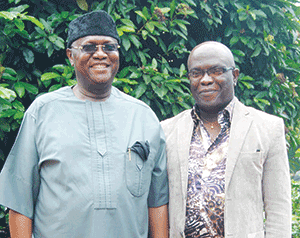The art and culture of two nations far removed from each other can have similarities even if the two have never crossed paths. This was evident when art lovers, critics and artists, among others gathered for the fifth edition of the Omooba Yemisi Adedoyin Shyllon Art Foundation (OYASAF) lecture series on September 24.
Delivered by Prof. Krydz Ikwuemesi of the University of Nigeria, Nsukka (UNN), it was titled: “Art and Culture among the Igbo of Nigeria and the Ainu of Japan in the Post-colonial Period: a critical survey”. In the succinct lecture the painter, art critic and ethno-aesthetician outlined the similarities and differences between the Igbo and Ainu art and culture.
After his introduction and background, Ikwuemesi took the audience through the Igbo Life Cycle, which he said is marked and circumscribed by a series of rites beginning from birth and culminating in death. Then the Igbo Education, Religion and Worldview, as well as, the Igbo Social Order and Justice. The lecturer, who studied the Ainu when he was on sabbatical in Japan around 2009, went on to do the same breakdown with the Ainu coming up with differences basically for social order and justice.
In the section of the paper that deals with art among the Igbo and Ainu, Ikwuemesi said the Igbo believe that art and life are complementary, while for the Ainu on the other hand, art is intertwined with life itself.
In concluding, Ikwuemesi said that “between the colonial and postcolonial trajectories, transition, change and continuity have defined art and culture among the Igbo and Ainu, although change, for the Ainu, has been very minimal”.
He explained that it is clear that Igbo and Ainu societies have had art throughout their histories but they did not have a single totalising word to describe the art experience.
“Both societies viewed art and the general ability to create as gifts from the gods which should be committed to the service of religion and the gods themselves,” he stated.
He further stated that “the commonalities and divergences in Igbo and Ainu arts are, therefore, only a micro pattern of the macro qualities that define the human species, as homo religious and homo aestheticus”.
All told, what emerges from the study of Igbo and Ainu art and culture is not a case of cultural diffusion between the two groups, as they are both distanced from each other without any contact. The study only foregrounds a good example of simul-development and thus inscribes art and culture as pan-human phenomena. In doing so, it underscores the uniqueness of the human species in spite of the diversity that defines the world.
Among the people at the lecture were: art patron and collector, Chief Rasheed Gbadamosi; sports analyst, Chuka Momah; Dr. Kunle Filani; artists Kolade Oshinowo, Olu Amoda and Adeola Balogun.
Before Ikwuemesi, the lecture series has had Professor Frank Ugiomoh of the University of Port Harcourt (UNIPORT) and Dr. Kunle Filani, then of the University of Ibadan (UI). There has also been Professor Jacob Jari of the Amadu Bello University (ABU), Dr. Ozioma Onuzulike (UNN) and Professor Albert Lavergne.













